
Actebia fennica, the black army cutworm or Eversmann's rustic, is a moth of the family Noctuidae. The species was first described by August Michael Tauscher in 1806. It has a Holarctic distribution from Newfoundland through western Europe, Siberia, the Far East, Mongolia, northern China to Korea and Japan. In North America it is mainly found in the boreal region, south to New England, southern Montana and northern Oregon.

Cucullia argentina is a moth of the family Noctuidae. It is found from central Turkey throughout the Caucasus, Iraq, Iran, Turkmenistan, southern Russia, Kazakhstan and Afghanistan to Mongolia.

Euxoa adumbrata, the sordid dart, is a moth of the family Noctuidae. The species was first described by Eduard Friedrich Eversmann in 1842. In North America it is found across northern Canada from Quebec to western Alaska, south to the northern parts of the United States, and in the mountains to Colorado. It is also found in Greenland, the coastal areas of Scandinavia and the Ural. It was recently recorded from Denmark, although this includes Euxoa lidia, which some authors regard to be a valid species.

Glacies coracina, the black mountain moth, is a moth of the family Geometridae. The species was first described by Eugenius Johann Christoph Esper in 1805. It is found in northern Europe and in mountainous areas from Norway, Sweden, Finland, Poland and northern Russia to Japan. It is also present in Great Britain, Romania and Bulgaria and in the Alps. It is found at elevations of up to 3,000 meters.
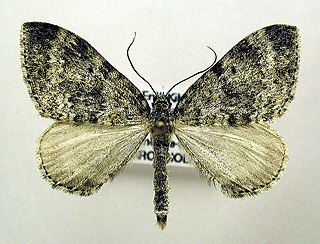
Entephria flavicinctata, the yellow-ringed carpet, is a moth of the family Geometridae. The species was first described by Jacob Hübner in 1813. It is found in the mountainous areas of the Palearctic realm The distribution is disjunct extending across the Pyrenees, the Alps, some lower mountains and then from Norway across the Arctic to northern Russia.

Epione vespertaria, the dark bordered beauty, is a moth of the family Geometridae.
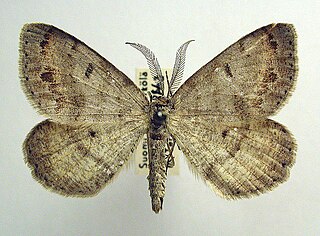
Macaria loricaria, the false Bruce spanworm or Eversmann's peacock, is a moth of the family Geometridae. It is found from Fennoscandia and the Baltic states to Sakhalin. It is also found in North America, where it is found from Alaska to Newfoundland and New York, south to Colorado.
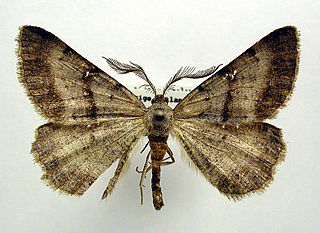
Selidosema brunnearia, the bordered grey, is a moth of the family Geometridae. The species was first described by Charles Joseph Devillers in 1789. It is found in central and southern Europe, Asia Minor, Transcaucasia and North Africa.
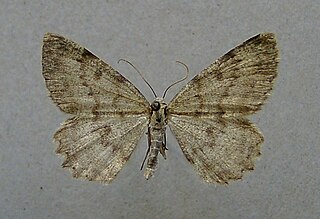
Charissa glaucinaria is a moth of the family Geometridae first described by Jacob Hübner in 1799. It is found in the mountains of central and southern Europe. In the east, it ranges to Turkey, Ukraine and Georgia. In the Alps it is found at altitudes of over 2,000 meters.

Apocheima hispidaria, the small brindled beauty, is a moth of the family Geometridae. The species was first described by Michael Denis and Ignaz Schiffermüller in 1775. It is found from Spain through central Europe to Russia. In the north, the range extends to southern Sweden. In the south, it is found on all of the Balkan Peninsula up to the Black Sea.

Godonela aestimaria, the tamarisk peacock, is a moth of the family Geometridae. It is found in southern and south-eastern Europe and the Middle East.

Narraga tessularia is a moth of the family Geometridae. It is found in Slovakia, Austria, Hungary, Romania, Bulgaria and Russia.
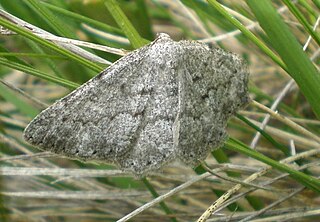
Elophos dognini is a moth of the family Geometridae. It is found in Spain, France, Andorra, Switzerland and Italy.

Boloria selenis is a species of butterfly in the family Nymphalidae. It is found from the Volga basin to Japan.

Crocallis tusciaria, the smoky scalloped oak, is a species of moth of the family Geometridae. It is found from Morocco through southern Europe and Asia Minor to the Caucasus, northern Iran and Turkmenistan. The eastern range extends to the southern Ural.

Scopula submutata, the Mediterranean lace border, is a moth of the family Geometridae. It is found in southern Europe, North Africa and the Near East. The habitat consists of open, dry grassland and rocky slopes.

Eupithecia silenicolata is a moth in the family Geometridae. It is found from southern Europe and Morocco to western Asia, Iran and Pakistan. In the north, the range extends to southern Switzerland, Austria and northern Italy.
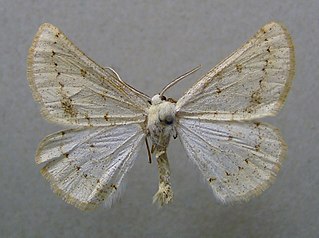
Dyscia conspersaria is a moth of the family Geometridae first described by Michael Denis and Ignaz Schiffermüller in 1755. It is found in south-eastern Central Europe and Asia Minor.

Conisania leineri is a species of moth of the family Noctuidae. It is found in Central Europe, along the Baltic Sea coast, eastward to the southern Ural.
Acleris obtusana, the small aspen leaftier moth, is a species of moth of the family Tortricidae. It is found in Norway, Sweden, Finland, Estonia and Latvia. It is also found in Russia and North America, where it has been recorded from Alberta, Indiana, Maine, Michigan, Montana, New Hampshire, New York, Ontario, Vermont and Wisconsin.




















